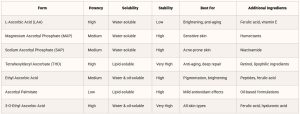

Vitamin C is a superstar ingredient in skincare, renowned for its ability to brighten, protect, and rejuvenate the skin. However, not all forms of vitamin C are created equal. With a variety of formulations available, understanding their differences can help you choose the one that best meets your skin’s needs.
Let’s explore the most commonly used forms of vitamin C, their stability, efficacy, and how they benefit your skin.
Why is Vitamin C Essential in Skincare?
Vitamin C offers a range of benefits:
• Antioxidant protection: Neutralizes free radicals that damage and age your skin, and cause mutations that lead to skin cancers.
• Brightening effect: Reduces hyperpigmentation by exfoliating outer skin layers to even out skin tone.
• Collagen synthesis: Stimulates new collagen production for firmer, more youthful skin.
• Anti-inflammatory properties: Helps soothe inflammation and irritation.
Forms of Vitamin C in Skincare
1. L-Ascorbic Acid (LAA)
• Potency: The purest and most potent form of vitamin C.
• Benefits: Highly effective in brightening the skin, reducing hyperpigmentation, and boosting collagen production.
• Stability: Extremely unstable in water and prone to oxidation when exposed to light or air.
• Additional Ingredients: Requires stabilizers like ferulic acid and vitamin E to enhance efficacy and prolong shelf life.
2. Magnesium Ascorbyl Phosphate (MAP)
• Potency: A stable, water-soluble derivative of vitamin C.
• Benefits: Effective for brightening and hydrating the skin; milder than L-ascorbic acid, making it suitable for sensitive skin.
• Stability: More stable in formulations but less potent than LAA.
• Additional Ingredients: Typically paired with humectants for better absorption.
3. Sodium Ascorbyl Phosphate (SAP)
• Potency: A stable, water-soluble form of vitamin C.
• Benefits: Known for its antibacterial properties, making it ideal for acne-prone skin.
• Stability: Stable in water-based formulations but requires a low pH for optimal absorption.
• Additional Ingredients: Often combined with niacinamide for anti-acne effects.
4. Tetrahexyldecyl Ascorbate (THD Ascorbate)
• Potency: A lipid-soluble form of vitamin C that penetrates deeper into the skin.
• Benefits: Excellent for reducing fine lines, improving skin elasticity, and delivering long-lasting antioxidant protection.
• Stability: Highly stable and less likely to oxidize.
• Additional Ingredients: Works synergistically with retinol and other lipophilic ingredients.
5. Ethyl Ascorbic Acid
• Potency: A relatively new, stable form of vitamin C.
• Benefits: Offers brightening and antioxidant effects similar to LAA but with better stability.
• Stability: Stable in both water and oil formulations.
• Additional Ingredients: Often paired with peptides or ferulic acid for enhanced benefits.
6. Ascorbyl Palmitate
• Potency: A fat-soluble derivative of vitamin C.
• Benefits: Provides mild antioxidant protection and is often used in anti-aging formulations.
• Stability: Stable but less effective than other forms of vitamin C.
• Additional Ingredients: Works well in oil-based products.
7. 3-O-Ethyl Ascorbic Acid
• Potency: A hybrid form combining the best properties of LAA and THD ascorbate.
• Benefits: Targets pigmentation and provides antioxidant protection.
• Stability: Stable in both water- and oil-based formulations.
• Additional Ingredients: Often paired with ferulic acid and hyaluronic acid.
Why Stability Matters in Vitamin C Products
Vitamin C is notoriously unstable and prone to oxidation, which reduces its efficacy. Formulations often include stabilizing ingredients like:
• Ferulic Acid: Enhances potency and stabilizes vitamin C.
• Vitamin E: Works synergistically to provide antioxidant protection.
• Hyaluronic Acid: Improves hydration and aids in product penetration.
• Low pH Formulations: Increase absorption but may irritate sensitive skin.
How to Choose the Right Vitamin C for Your Skin
• For sensitive skin: Opt for MAP or SAP.
• For oily or acne-prone skin: Choose SAP or Ethyl Ascorbic Acid.
• For anti-aging benefits: THD Ascorbate is an excellent choice.
• For maximum potency: L-Ascorbic Acid delivers the most dramatic results, provided it’s stabilized properly.
| Form | Potency | Solubility | Stability | Best For | Additional Ingredients |
|---|---|---|---|---|---|
| L-Ascorbic Acid (LAA) | High | Water-soluble | Low | Brightening, anti-aging | Ferulic acid, vitamin E |
| Magnesium Ascorbyl Phosphate (MAP) | Medium | Water-soluble | High | Sensitive skin | Humectants |
| Sodium Ascorbyl Phosphate (SAP) | Medium | Water-soluble | High | Acne-prone skin | Niacinamide |
| Tetrahexyldecyl Ascorbate (THD) | High | Lipid-soluble | Very High | Anti-aging, deep repair | Retinol, lipophilic ingredients |
| Ethyl Ascorbic Acid | Medium | Water & oil-soluble | High | Pigmentation, brightening | Peptides, ferulic acid |
| Ascorbyl Palmitate | Low | Lipid-soluble | High | Mild antioxidant effects | Oil-based formulations |
| 3-O-Ethyl Ascorbic Acid | High | Water & oil-soluble | Very High | All skin types | Ferulic acid, hyaluronic acid |
Final Thoughts
Incorporating vitamin C into your skincare routine can be transformative for your skin. By understanding the unique properties of each form, you can select a product tailored to your skin type and concerns. Whether you’re looking for brightening, anti-aging, or acne-fighting properties, there’s a form of vitamin C that’s perfect for you.
Make sure to pair your vitamin C product with sunscreen during the day for maximum protection and results. A little daily commitment to this powerhouse ingredient can go a long way toward achieving radiant, healthy skin!
